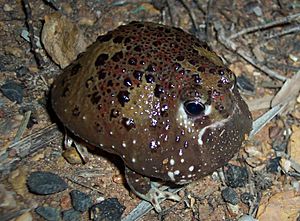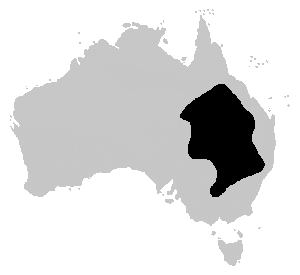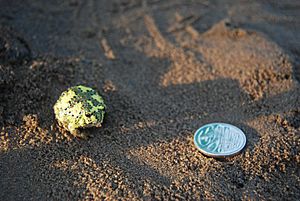Crucifix toad facts for kids
Quick facts for kids Crucifix toad |
|
|---|---|
 |
|
| A male crucifix toad. | |
| Conservation status | |
| Scientific classification | |
 |
|
| Range of the crucifix toad |
The crucifix toad, also known as the holy cross frog, is a special kind of frog. It belongs to the frog family called Limnodynastidae. This amazing frog lives mostly underground, which means it is a fossorial animal.
It is one of the few Australian frogs that uses bright colours to warn others. This warning system is called aposematism. It tells predators, "Hey, I might not taste good!" You can find this unique frog in western New South Wales and south-western Queensland, Australia.
Contents
What Does the Crucifix Toad Look Like?
The crucifix toad is very easy to spot among other frogs in its group, Notaden. Most frogs in this group are dark brown. But the crucifix toad is super colourful!
Its back is bright yellow. On its back, it has a colourful cross shape. This cross is outlined with big black dots. Inside the cross, you'll see white, black, and red dots. Its belly is white, and its sides are blue.
Size and Shape
This frog is small and very round. It has a blunt nose and small legs and feet. Because it lives underground, its eardrum (called a tympanum) is hidden.
Male crucifix toads can grow up to 6.3 centimetres (2.5 inches) long. Females are a little bigger, reaching about 6.8 centimetres (2.7 inches). Their feet have small "spades" that help them dig deep into the ground.
How Does the Crucifix Toad Live?
The crucifix toad lives on the ground in dry areas of western New South Wales and Queensland. It has a clever way to survive long dry periods. It simply burrows deep underground and becomes less active. This helps it save energy and stay safe until the rain comes.
Breeding and Tadpoles
When there's a lot of heavy rain, these frogs come out of the ground. They start breeding in temporary ponds that form after the rain. The male frogs make a "woop" sound from inside the pond to attract females.
The tadpoles grow up very quickly. This fast growth helps them make the most of the wet conditions. It also reduces the chance of them dying if the pond dries up too soon. The whole cycle, from egg to froglet, can be over in just six weeks!
Amazing "Frog Glue"
When the crucifix toad feels threatened, it can release a sticky, stretchy "frog glue" from its back. Scientists are still studying exactly why it does this. It might be to confuse or scare away predators like snakes. Or, it could be to trap biting insects. The frog might then eat these trapped insects when it sheds and eats its skin.
Interestingly, male crucifix toads have been seen using this glue during mating. They use it to stick themselves onto the larger females. This special glue is even stronger than some non-toxic medical adhesives available today. It's a protein-based glue that works even when wet!
What Do They Eat?
The crucifix toad mainly eats ants and termites. These insects are a common food source for many animals living in dry areas.
See also
 In Spanish: Sapo crucifijo para niños
In Spanish: Sapo crucifijo para niños



